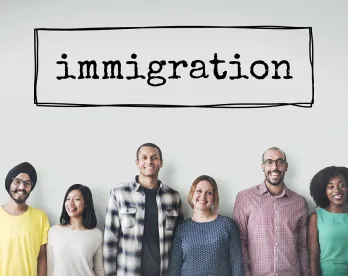The U.S. Supreme Court has heard oral argument on whether the Department of Homeland Security (DHS) lawfully terminated the Deferred Action for Childhood Arrivals (DACA) Policy. The Court’s decision in a consolidated case (Homeland Security v. Regents of the University of California, Nos. 18-587, 588, and 589) will affect more than 700,000 individuals who came to the U.S. as children without proper documentation.
For the past seven years, DACA has given those who meet the eligibility requirements protection from deportation and permitted them to work legally and obtain and maintain other benefits, such as driver’s licenses and health insurance. They are generally college-educated, high-skilled workers, members of the military, and heads of families that include U.S. citizen children. The overwhelming majority of Americans support a path to citizenship for these individuals, commonly referred to as “Dreamers,” after the DREAM Act proposed in 2017, but never passed.
Approximately 1,400 organizations, including civil rights organizations, universities, and national security leaders, have filed friend-of-the-court briefs in support of the Dreamers.
Questions Presented
The Supreme Court will decide whether DHS’s decision to wind down the DACA Policy:
- 1. Is judicially reviewable; and
- 2. Is lawful if it is reviewable.
Arguments Before the Court
DHS
In its brief, DHS argued that DACA was lawfully terminated because, in U.S. v. Texas, 136 S. Ct. 2271 (2016), the Supreme Court affirmed, by its equally divided vote, that Deferred Action for Parents of Americans and Lawful Permanent Residents (DAPA) and an extension of DACA should be enjoined as both programs were likely unenforceable. DAPA would have allowed undocumented parents of U.S. citizens and “Green Card” holders to apply for deferred deportation and employment authorization. The DACA extension would have expanded employment authorization.
Perhaps recognizing an affirmation by an equally divided court is not necessarily precedent, DHS also argued that its action was not reviewable because the action was committed to agency discretion by law and the Immigration and Nationality Act places no limit on the DHS’s authority to simply resume enforcing laws regarding deportation. DHS further argued that even if the action was reviewable under the Administrative Procedure Act, the action was not “arbitrary and capricious” because the DHS presented “multiple, independently sufficient grounds for withdrawing DACA.”
What are those reasons?
Initially, Elaine Duke, then-Acting DHS Secretary, proffered that DACA was being terminated based on U.S. v. Texas and a letter from then-Attorney General Jeff Sessions stating that DACA was unconstitutional.
In response to a decision from the U.S. District Court for the District of Columbia, then-DHS Secretary Kirstjen Nielsen issued a subsequent memorandum setting forth the DHS decision terminating DACA as follows:
- DHS made a rational judgment to stop facilitating ongoing violations of federal law on a massive scale;
- Maintaining a possibly illegal policy would undermine public confidence in the rule of law and encourage more illegal immigration;
- States were threatening litigation to stop DACA and dealing with that litigation would have been burdensome to DHS;
- A policy like DACA should be undertaken only with Congressional approval; and
- DACA was meant only to be temporary.
Regents of the University of California
The Regents of the University of California, challenging DHS’s decision terminating the DACA program, focused on the “life-changing implications” for more than 700,000 beneficiaries of DACA and their families, employers, universities, and the economy if DACA were eliminated. They noted the U.S. has a history of providing deferred action when anything else would be “unconscionable.” They reminded the Court that DACA participants have an employment rate of 91 percent, that they support families (including 200,000 U.S. citizen children), and that rescission of the program would cost $215 billion in lost GDP and $60 billion in lost federal tax revenue over a 10-year period.
As to the law, the Regents argued that there is a strong presumption in favor of judicial review and the rescission of DACA is clearly reviewable because DHS itself stated that DACA is unconstitutional. If DHS thinks DACA is unconstitutional and, therefore, illegal, that is a matter of law courts can review. The Regents also argued the decision to rescind was arbitrary and capricious because the Court is limited to reviewing DHS’s initial reasoning, not its post-hoc reasoning. Even if the reasons given by DHS are considered, the Regents argued those reasons fall short. On this, author Linda Greenhouse questioned whether the Supreme Court’s decision against the Administration in the census case, Department of Commerce v. New York, might come into play because of a lack of “reasoned decision making.”
The Oral Argument
In the oral argument, the Court appeared split along liberal-conservative lines.
U.S. Solicitor General Noel J. Francisco, arguing on behalf of the DHS, focused on the Administration’s belief that DACA was illegal, that a decision to enforce the law was unreviewable, and that the reasons for the rescission and wind down of DACA were “eminently reasonable.” The liberal wing of the Court pushed back with their questions. They focused on the reliance interests involved and whether those were adequately considered by Secretary Duke and Secretary Nielsen. Justice Stephen Breyer brought up the reliance interests not only of the 700,000 DACA beneficiaries, but of the “66 health organizations, 3 labor unions, 210 educational associations, 6 military organizations, 3 home builders, 5 states, 108 municipalities and cities, 129 religious organizations and 145 businesses” that have weighed in in favor of the DACA recipients. Justice Elena Kagan noted that she did not see any consideration given to those interests in the Duke or Nielsen memos. Justice Sonia Sotomayor agreed that a lot of the reliance interests were not considered, and that the DHS decision was not just a legal decision, but “about [the Administration’s] choice to destroy lives.” Justice Ruth Bader Ginsburg thought that even Nielsen’s memo was “infected by the idea” of illegality, and without that idea, the Administration would have to stand up and say “[w]e don’t like DACA.”
Theodore Olson and California Solicitor General Michael Mongan, arguing for the individual DACA recipients and the University of California, also focused on reliance and the DHS taking responsibility for its decision. Olson stated the DHS was hiding behind the illegality reasoning. Mongan argued the DHS should have to issue a more reasoned decision “so that the public could hold them accountable for the choice” they make. Justice Samuel Alito, perhaps indicating the decision was not reviewable, focused on understanding what agency decisions would and would not be reviewable. Justice Brett Kavanaugh said that, to him, the DHS’s decision seemed reasoned enough and agreement with the decision was not necessary. Chief Justice John Roberts suggested that relying on the DAPA decision might be a good enough reason. He said, “You’ve got a court of appeals decision affirmed by an equally divided Supreme Court. Can’t he just say that’s the basis on which I’m making this decision?” Roberts likely is the swing vote on the Court.
Next
The decision in the case is not expected until June 2020. Until then, court injunctions allow DACA beneficiaries to remain in the U.S. and renew their statuses. If the Supreme Court holds that the wind down decision was lawful, Dreamers otherwise without status would have to leave the U.S. While President Donald Trump has at various times indicated he would work with Congress to allow DACA members to remain in the U.S., those efforts to date have failed. Should the Supreme Court find DHS lawfully terminated DACA, Congress and the President will have to consider action in response to overwhelming public support for the Dreamers.





 />i
/>i

